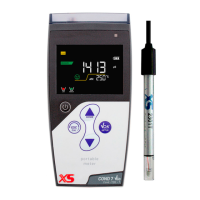27
Rev. 1.0 30.01.2020
To determine the calibration coefficient of a solution, the following formula is applied:
= 100
2
−
1
1
(
2
− 25
)
−
2
(
1
− 25)
Where tc is the temperature coefficient to be calculated, C
T1
and C
T2
are Conductivity at temperature 1 (T1)
and at temperature 2 (T2).
Each result with “correct” temperature is plagued by an error caused by the temperature coefficient. The
better the temperature correction, the lower the error. The only way to eliminate this error is not to use the
correction factor, acting directly on the sample temperature.
Select 0.00% / °C as the temperature coefficient to deactivate the compensation. The displayed Conductivity
value refers to the temperature value measured by the probe and not related to a reference temperature.
P3.6 COND Calibration Data
Access this menu to get information on the last calibration performed. The following screens will
automatically scroll on the display.
• First screen: beakers indicating the buffers used for calibration.
• Second and possibly third, fourth and fifth screens: Value of the actual cell constant in the
measurement range indicated by the beaker.
Note: The instrument accepts calibrations with a maximum tolerance of 40% on the nominal value of the
cell constant only.
P3.8 COND parameter Reset
If the instrument does not work properly or incorrect settings have been made, confirm YES with the key
to return all the parameters of the pH menu to the default settings.
P3.9 Temperature calibration
All the instruments in this series are pre-calibrated for a correct temperature reading. However, if there is a
difference between the measured and the real one (usually due to a probe malfunction), it is possible to
perform an offset adjustment of + 5°C.
Use the keys and to correct the temperature offset value and confirm with .
• Automatic Cond calibration
Example: one-point calibration (1413 µS/cm) using a cell constant sensor 1
• In COND measurement mode press the key to enter the calibration mode.
• Rinse the cell with distilled water and dab gently with paper towel.
Start with a few ml of standard solution. Dip the sensor in the standard 1413 µS / cm, keeping it slightly

